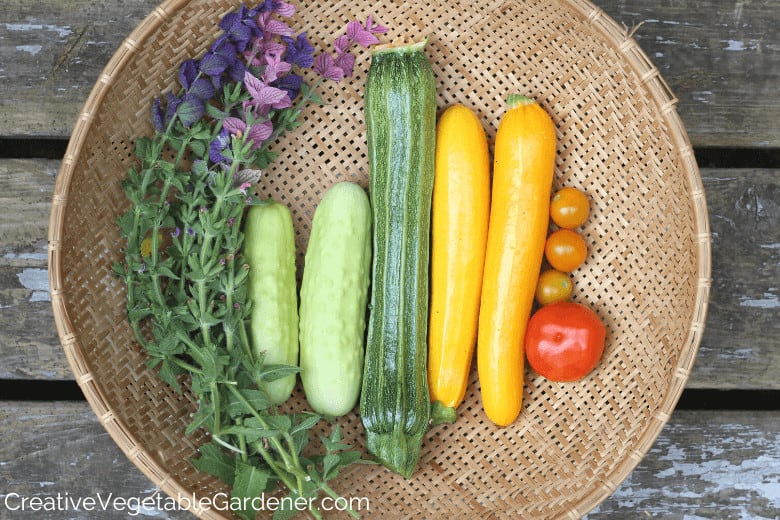
Zucchini continues to be one of the most popular squashes. A versatile vegetable, it can be eaten raw or cooked, and it can be enjoyed by itself or included in casseroles and pasta dishes. People not only love to eat it, but they also love growing zucchini. It’s a popular crop with home gardeners, perhaps because it grows well in most climates and produces abundant fruit.
If you’re thinking of including zucchini in your garden, but are a little nervous about trying it for the first time, relax! You don’t have to have a green thumb to grow it.
It does, however, help if you understand a little about the process of growing zucchini. In this article, I’ll share an overview of how to plant and care for zucchini and when to harvest zucchini.
How Long Does Zucchini Take to Grow?
The first step in growing zucchini is to understand the difference between summer squash and winter squash. While both summer and winter squash grow during the warm season, winter squash is harvested in the fall.
Summer squash, including zucchini and yellow squash, produce fruit throughout the summer and into the early fall.
Zucchini loves heat, and it can’t tolerate frost. It’s not even very fond of cool weather, so you want to wait until late Spring, after the nights and the soil have warmed, to plant it.
The seeds should germinate within one to two weeks, depending on soil and weather conditions.
After germination, the plants grow quickly, and you can expect them to start blooming within 45 to 50 days after planting. Then, the fruit will begin to appear, and it grows very rapidly. Within a few days after it appears, the fruit should be ready for harvesting.
Before you harvest, you’ll want to learn more about when to harvest zucchini.
Growing zucchini, from planting to harvesting, only takes about 60 days if the soil and air are warm enough.
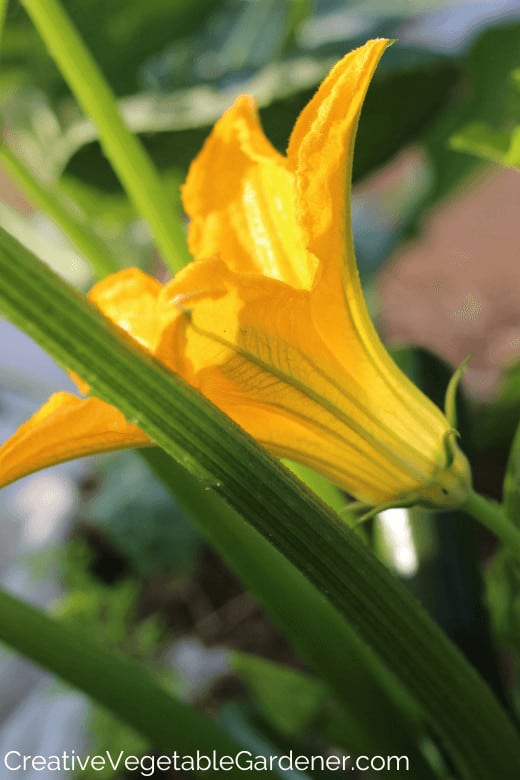
When to Plant Zucchini
Zucchini is a summer annual that is planted in the spring after the weather and soil have warmed.
The first thing to remember about growing zucchini is that it is a heat-loving plant. At the least, you want to make sure that all danger of frost has passed before you plant. If possible, wait until you can be reasonably sure that it will remain above 50 degrees at night.
In my Wisconsin 5a/b garden I usually plant my zucchini in the second or third week of May depending on the weather.
If you ljve in a cold climate with a shorter summer season, you may want to get an early start by starting the seeds indoors in containers. If you choose this option, you’ll want to start your zucchini seeds about six weeks before your anticipated planting date.
If you do start seeds in containers, make sure that you allow the young seedlings time to harden off by leaving them outside in a protected area for a few days before you set them into the ground. Remember, though, that you don’t want to leave the containers out at night if there’s a chance of frost.
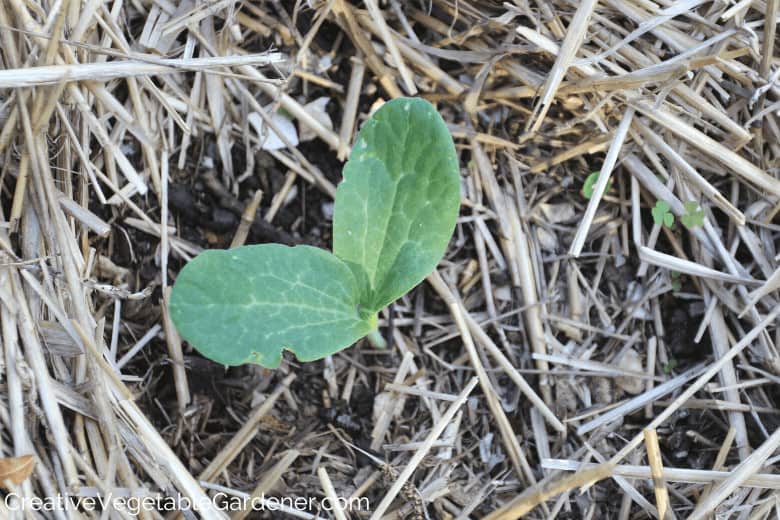
How to Plant Zucchini Seeds
Growing zucchini isn’t a difficult process, and it’s easy to get started. Before you begin, you might want to do some research on the different varieties of zucchini and decide which one is right for you. Some zucchini grow quite large, so if space is limited, you could consider one of the more compact varieties. See below for more about varieties.
Once you’ve decided what to grow, you basically have three options for planting zucchini.
#1: Sow seeds
If you choose to sow seeds directly into the ground, wait until the weather and the soil warm in the spring. Because zucchini craves sun, pick a very sunny location. If possible, try to find one that’s sheltered from the wind because high winds can sometimes interfere with pollination.
Sow the seeds about one inch deep and three feet apart. Or, if you choose to grow in hills, or mounds, sow three to four seeds in each mound. You’ll need to thin them later though.
#2: Start seeds indoors
A second option as we discussed above is sowing the seeds indoors in containers.
#3: Buy seedlings
A third option is to buy young plants. This will give you a jump-start on the season because you won’t have to wait for the seeds to germinate. This is my favorite option because I only grow one or two zucchini plants each season. It’s not worth it to me to buy an entire packet of seeds, so I purchase plants instead.
If you do buy plants, make sure that you choose healthy plants that have been outdoors long enough to become acclimated to the weather. I have share some best practices on where to buy vegetable plants.
No matter which option you choose, prepare the soil for planting by applying organic garden fertilizer and compost.
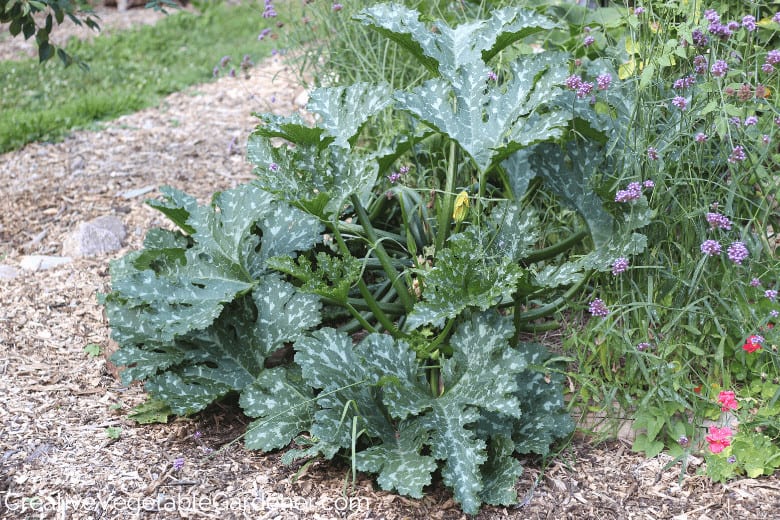
Sometimes I plant my zucchini plants at the ends of my raised beds so they can sprawl a bit.
How Far Apart to Plant Zucchini
Growing zucchini is fun and simple, but there are some pitfalls. The two most common mistakes that first-time growers make is growing too many plants and spacing the plants too closely.
One zucchini plant can produce an abundance of fruit. If you’re growing zucchini for the first time, I recommend only planting one or two plants. I usually grow two in my garden and sometimes that feels like too many!
It’s also crucial to remember that the little seed that you’re planting today will quickly grow, and many zucchini plants can become quite large. Some varieties can produce vines that might extend to six feet, and the larger bush varieties can grow up to four feet across.
So, plan accordingly. Before you begin, research the varieties and be familiar with how large your plants will grow.
For most varieties, you want to make sure that your rows are at least two or three feet apart. Zucchini seeds germinate fairly easily, so I usually plant two seeds per hole and then thin it to one after they’ve begun to produce healthy leaves if they both germinate. You want to thin out the weaker plants so that the healthy, vigorous ones will have more room to grow.
Of course, if you have limited space, you still have some options. You can select a small variety, or you can try growing zucchini vertically.
If you live in a wet, humid climate, you may want to space your plants further apart. If they’re too close together, it’s harder for the air to circulate around the plants, and you’re likely to be plagued by diseases such as powdery mildew.
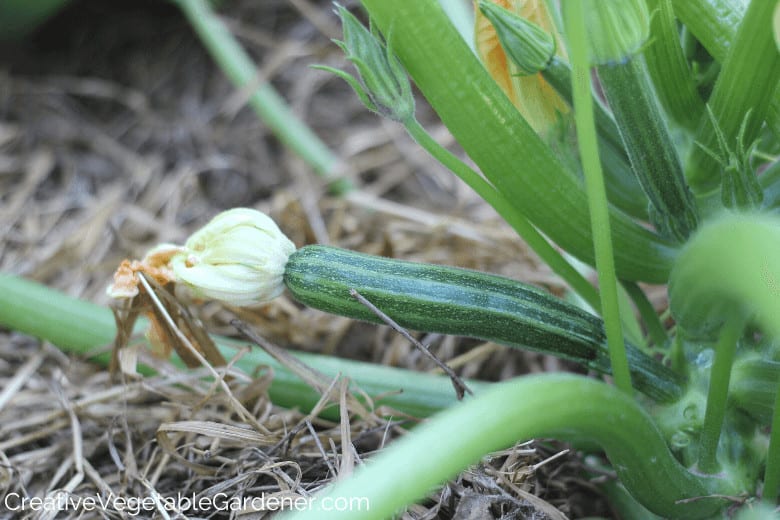
Watering Zucchini
Like most summer veggies, Zucchini requires plenty of water to reach optimal growth and production. One inch of water per week is ideal, so remember to water if the rainfall isn’t adequate.
It’s best if the water is applied slowly so that it can penetrate down to the roots. A drip irrigation system is the most efficient way to water your garden, but if you don’t have one, water slowly. Try laying the hose on the ground and letting the water seep into the soil evenly.
Zucchini, like most vegetable plants, also requires good drainage. Do not overwater, and try to avoid overhead watering.
If you spray the plants overhead with a hose, you’re likely to lose a lot of water to evaporation. Most of what doesn’t evaporate will fall onto the plant’s leaves, where it can create the perfect conditions for diseases such as powdery mildew to grow.
I keep my entire garden covered in a thick layer of vegetable garden mulch. This helps retain soil moisture, breaks down to add organic matter, and protects the soil from becoming compacted from rain or blowing away in high winds.
Here are some more secrets to watering your vegetable garden the right way.
You can set the seedlings outside when the weather has warmed and the young plants have produced three or four healthy leaves. If the nights are still a little cool in your area, it’s a good idea to harden the plants off by setting the containers outside in a sheltered area to get the plants acclimated before you set them directly into the ground.
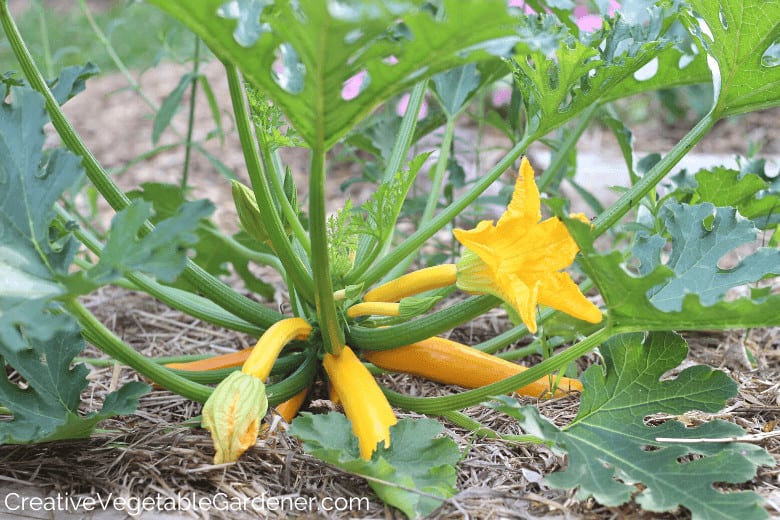
Zucchini Types
Before growing zucchini, you might want to learn something about the different types so that you can choose what’s right for you.
When most people think of zucchini, they think of the deep greens and the elongated shapes of the Black Beauties or Ravens. Some types, however, are lighter in color, and some are mottled with white or very pale green streaks. And yes! There are even gold and bright yellow zucchini.
The shape, too, can range from the long cylinder-shaped zucchini that we all recognize to fruits that are egg-shaped, or even round.
Eight Balls and Cue Balls are among the round zucchini, while traditional, cylinder-shaped zucchini include Black Beauties and Green Machines.
Zucchini can also vary according to size and plant behavior. While many, such as Black Forest, grow on vines, there are more bush varieties, including Bush Babies and Patio Star, to choose from.
To get inspired, take a look at all of the different varieties of zucchini listed on Johnny’s Selected Seeds’ website.
With so many choices, how do you know what’s right for you? Read on to learn more about the specific varieties of zucchini.

This is a great example of how large just one zucchini leaf can get!
Zucchini Varieties
All zucchini are delicious, so selecting a variety is largely a matter of choosing what would work best for you. Consider how much space you have available, how long your growing season is, and what your own gardening preferences are.
How much space do you have?
Space is probably the most important consideration. Many older heirloom varieties, particularly those that grow as vines, require a great deal of space.
If you’re space challenged, try one of the more compact bush-types, including Bush Baby or Patio Star. These varieties can even be grown in containers if you’re a patio gardener.
What’s your summer weather?
Climate is another consideration. While zucchini grows well in most temperate climates, wet weather or very short growing seasons can present challenges.
If you live in a wet or humid summer climate, you may have experience with powdery mildew on your vegetable crops. There are more disease-resistant varieties for these regions, such as Payroll, Dunja, and Yellowfin.
How long is your growing season?
If you have a very short growing season, or you just chose to plant late in the season, some varieties to consider include Black Beauty, Green Machine, and Dunja.
How do you feel about the spikiness of zucchini plants?
Some gardeners despise getting their hands scratched on the spiny vines while they’re tending or harvesting squash. If you have this problem, try one of the spineless varieties, including Spineless Beauty, Spineless Perfection, and Easy Pick Gold II.
Do you like to experiment with colorful varieties?
Aesthetics are important to many gardeners (me!) who are attracted to colors and shapes to brighten up their gardens, and those bright colors can tempt finicky children (and adults) to eat their veggies.
If you prefer something besides the traditional green, try one the golden varieties instead, such as Easy Pick Gold II or Zucchini Golden.
The round zucchinis are super fun and unique, especially for kids, so look for the Ball Series, including Eight Ball, Cue Ball, and Lucky 8.
Renee’s Garden has a great selection of compact plants, round varieties, and even a packet with a mixture of three different varieties.
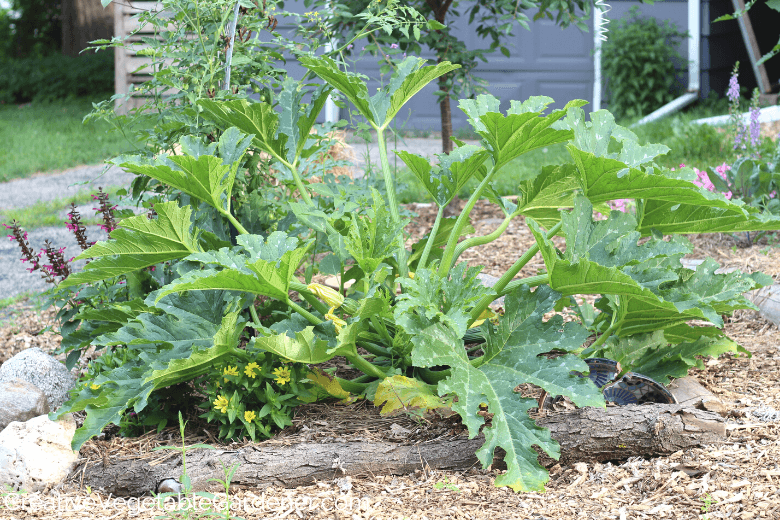
Growing Zucchini in a Raised Bed
You may, like some gardeners, struggle with extremely compacted, poorly-drained soil. Or, you may have back problems, or you just don’t like to get down on your hands and knees on the ground.
Still, you’re interested in growing zucchini, so what should you do? Growing zucchini vertically is one option for you, and another is growing zucchini in a raised bed.
You can create a raised bed within a wooden frame, or just by creating a mound on the ground. I usually build my beds 6-12 inches high, but you can make them as high as you want if you have plenty of soil. I share three options for creating easy raised garden beds, with lots of photos from when I built my garden.
If you choose to create a mound on the ground, first decide how large you want it to be. Different varieties of zucchini have different space requirements, but in general, you want to plan on growing two to three plants in a garden bed that’s four feet wide and four feet long.
If you’re growing in a smaller raised bed, you might consider growing one of the more compact varieties, such as Eight Ball, Cue Ball, or Piccolo.
Drainage and soil health are two keys to growing zucchini, and pretty much every vegetable, successfully. Whether you choose a wooden frame or simply a mound for your raised best, you should be familiar with what is the best soil for a vegetable garden.
I also recommend adding an organic garden fertilizer to all new raised beds because in my experience the soil is often of poor quality, no matter what mix you use or where you get it.
Keep the raised bed evenly moist, and you should be blessed with delicious, abundant zucchini throughout the growing season.
Zucchini is one of the easiest and most fun vegetables to grow, especially for beginning gardeners. It doesn’t need much maintenance, produces a ton of fruit, and grows quickly and easily in summer weather. The main challenges are that many of the plants grow to very large size so they can dominate other plants, and if you plant too many plants you’ll be tempted to leave zucchini on your neighbor’s front steps and run away! Overall, growing zucchini is a fun and rewarding summertime project for home gardeners.





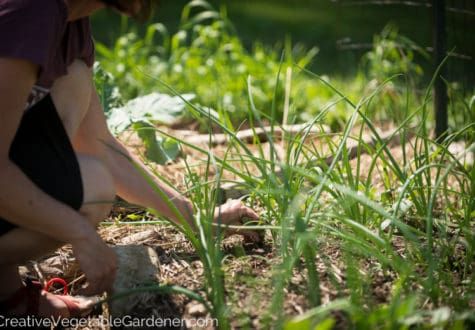



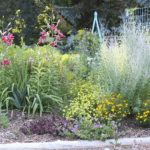
Comments
[…] out more about growing zucchini and how to pick the best […]